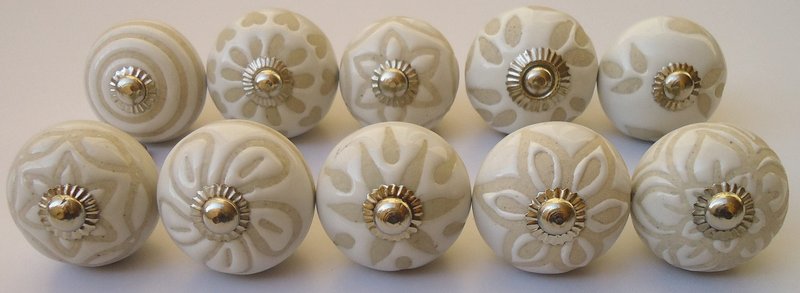
But don’t worry! Cleaning and brightening these knobs can be a straightforward task with the right approach. You might be asking, “What’s the best way to handle porcelain?” Well, you’re in luck! This guide will take you through some effective methods to restore those vintage treasures to their former glory.
Why Clean Vintage White Porcelain Knobs?
First off, let’s talk about *why* you even need to clean vintage porcelain knobs. Over time, they can accumulate dust, grease, and stubborn stains that not only make them look dingy but can also hide their intricate designs. Keeping them clean not only enhances their appearance but also helps prevent damage.
When dirt settles in the crevices, it can be tough to remove later on. Plus, cleaning these knobs can ensure they last for years, maintaining their vintage charm. So, if you want your porcelain knobs to shine, it’s essential to treat them right!
Gather Your Cleaning Supplies
Before diving into the cleaning process, make sure you’ve got all the necessary supplies. Here’s what you’ll need:
- Microfiber Cloth: Soft and non-abrasive, perfect for gentle cleaning.
- Dish Soap: A mild detergent works wonders for most grime.
- Baking Soda: This natural abrasive helps tackle tougher stains.
- White Vinegar: A great natural cleaner that cuts through grease.
- Soft Brush: A toothbrush or paintbrush can help get into the fine details.
Having these items ready will make the process smoother. It’s like having all your ingredients prepped before cooking a meal—much easier to create something delicious!
Basic Cleaning Method
For a quick clean, start with a simple method using dish soap and water. Here’s how:
1. Mix the Solution: In a bowl, combine warm water with a few drops of dish soap. Stir it gently to create a soapy mixture.
2. Soak the Cloth: Dip a microfiber cloth into the soapy water and wring it out. You want it damp, not dripping.
3. Wipe Down the Knobs: Gently wipe the knobs, paying attention to any grooves or design elements. You might be surprised at how easily dirt lifts away.
After cleaning, use a dry cloth to buff the knobs and remove any leftover moisture. It’s a simple method, but it works wonders for regular upkeep.
Removing Stains with Baking Soda
Sometimes, those pesky stains need a more robust solution. This is where baking soda shines. Here’s how to use it effectively:
1. Create a Paste: Mix baking soda with a bit of water until you get a thick paste.
2. Apply the Paste: With a toothbrush, gently rub the paste onto the stained areas. The mild abrasiveness of the baking soda will help lift the stain without scratching the porcelain.
3. Rinse and Dry: After a few minutes, rinse with a damp cloth and dry thoroughly.
This method is like a mini spa treatment for your knobs, rejuvenating them without harsh chemicals.
Using Vinegar for Deep Cleaning
For deeper stains or yellowing, vinegar can be your best friend. It’s acidic enough to tackle tough grime without being too harsh. Here’s how to use it:
1. Spray the Knobs: Fill a spray bottle with equal parts water and white vinegar. Spray it directly onto the knobs.
2. Let It Sit: Allow the vinegar solution to sit for about 5-10 minutes. This will give it time to break down stubborn stains.
3. Scrub Gently: Use a soft brush to scrub the knobs gently. The vinegar will help lift away dirt while leaving the porcelain intact.
Remember to rinse with water after scrubbing to remove any vinegar residue. It’s like giving your knobs a refreshing wash!
Preventing Future Grime
Once your vintage porcelain knobs are sparkling, you might be wondering how to keep them that way. Preventive measures can save you time in the long run. Here are some tips:
– Regular Dusting: A quick dusting with a microfiber cloth every few weeks can prevent buildup.
– Avoid Harsh Cleaners: Stay away from abrasive pads or chemical cleaners that can scratch the surface.
– Handle With Care: Be gentle when touching the knobs. Oils from your hands can attract dirt, leading to quicker staining.
Think of these steps as routine maintenance for your vintage knobs—just like checking your car’s oil or washing your windows regularly.
Restoring Shine
After cleaning, you might want to give those porcelain knobs a little extra shine. Here’s a simple method using a few household items:
1. Olive Oil and Lemon Juice: Mix a small amount of olive oil with lemon juice. The oil adds shine while the acid in lemon helps with any dullness.
2. Apply Sparingly: Use a clean cloth to apply the mixture to the knobs. A little goes a long way—too much can leave a sticky residue.
3. Buff: Once applied, buff the knobs gently with another clean cloth. You’ll be amazed at the shine!
This technique not only brightens the knobs but also gives them a protective layer to fend off dirt.
When to Seek Professional Help
Though regular cleaning usually does the trick, there might be times when your vintage porcelain knobs need some professional care. If you notice:
– Cracks or Chips: This could lead to further damage if not handled correctly.
– Severe Discoloration: Sometimes, stains may be deeply embedded, requiring professional cleaning methods.
In these cases, it’s wise to consult with a restoration expert. They can use specialized techniques to preserve and restore your knobs without compromising their integrity.
In conclusion, keeping your vintage white porcelain knobs clean and bright doesn’t have to be daunting. With a few simple steps and some common household items, you can maintain their beauty and charm for years to come. Just remember, a little love and care can go a long way in preserving the character of your beloved vintage pieces!